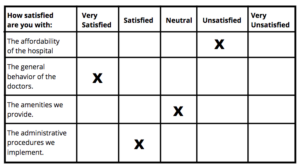What is a Likert Scale and How to Create One
Are you interested in finding out what you can use to measure questions that are neither agreed nor disagreed? A Likert scale can help you measure attitudes and opinions with a greater degree of nuance than simple binary questions, which offer only two answer options. Please read our blog post to learn what is a Likert scale and how to create one for your next survey.
1. What is a Likert scale?
The Likert scale is one of the most popular rating scales developed to measure one’s attitudes or opinions. Fixed choice response formats are used to determine how people feel about the topic, products, services, or experience. The scale deems that the strength/intensity of the experience is linear. These linear scales measure points of agreement/disagreement. People are given five to seven choices, or even nine balanced responses, that often come with a neutral point.
2. Common Likert Scale Question
A Likert scale does not have a fixed number of leveled items. Many researchers use five levels, but some also use 4, 7, 9, and even 10-leveled items. Since adding more levels produces diverse valuations, a 5 or 7 level scale is most often ideal for avoiding extreme options by obtaining just a bit of variation.
Below are some examples of Likert scale questions and answers:
a. Agreement
The employee training provided the knowledge I need to do my work efficiently.
- Strongly Disagree
- Disagree
- Undecided
- Agree
- Strongly Agree
b. Satisfaction
How satisfied are you with our customer support?
- Highly Dissatisfied
- Dissatisfied
- Neutral
- Satisfied
- Highly Satisfied
c. Frequency
How often do you visit our store?
- Very Frequently
- Frequently
- Occasionally
- Rarely
- Never
3. When to Use Likert Scales

Likert scale is useful in measuring the general feeling or opinion of a particular topic, product, services or experience, and collecting additional data on the factors that contribute to those feelings or opinions. However, a Likert scale should only be used when the question items are related to each other and can be presented in a degree-scale form. Since respondents are not limited to a yes/no answer, a Likert scale allows researchers to obtain quantitative data that can be easily analyzed. Nevertheless, a Likert scale may be compromised because of “social desirability”. Social desirability is the bias exhibited by people to present themselves in a positive light in the community. For example, in taboo questions involving sex, illegal drugs, or racism, respondents may heighten “good behavior” or depress “bad” or undesirable behavior of their responses. One way to reduce social desirability bias is by allowing anonymity on self-administered surveys. A study by Paulhus (1984) found that when respondents have to put their name, address, and telephone number on the survey, results show more positive personality characteristics than an anonymous survey.
4. How to create a Likert Scale
Establish the footing of your survey questions and response scale by first deciding what you want to measure. It is best to use a Likert scale when several factors are influencing the way your respondents feel about something. For instance, you want to measure patient satisfaction. Many factors affect patient satisfaction, including affordability, general behavior of doctors, amenities, and administrative procedures. The respondents’ opinions, attitudes, feelings, or experience must be measurable in a scale form. Moreover, make sure that there are two well-defined extremes for the response.
For Example:

Recommendation
- A Likert scale should have the same number of positive and negative responses.
- Stay odd. Provide your respondents with a neutral option.
- Use the appropriate description to label response. When you just use numbers, people may obscure which end is affirmative and which is undesirable.
- Make sure your survey questions are specific
- Use terms that your target audience understands
- Avoid bias questions
- Avoid long and complicated questions
- Avoid double-barreled questions
Check out our post on How to Write Great Survey Questions
You’ve most likely encountered Likert scale questionnaires without even knowing it. Likert scale questions are valuable for assessing people’s opinions on a specific topic when undertaking in-depth research.
For more information on data collection techniques or any aspect of mail survey management, contact us today! We provide outstanding quantitative data collection services and paper scanning services!
Get more information on – survey research services incentive fulfillment services or survey mailing services





